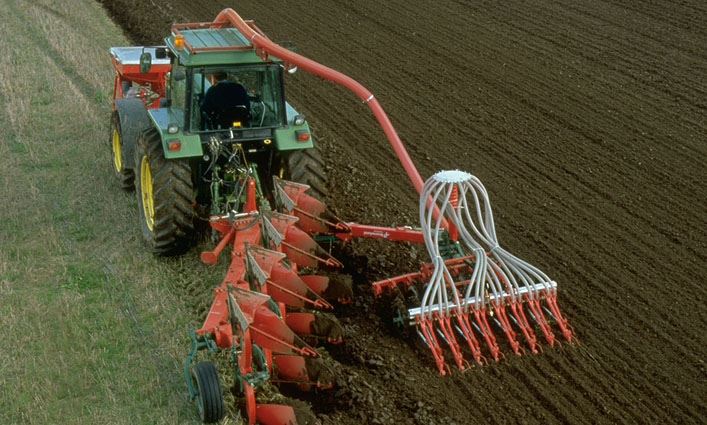Untapped potential for high-strength steels in agriculture
The face of agriculture has changed tremendously over the past 20 years or so. Average farm sizes have increased and agriculture has become more intensive. This in turn means tractors and other agricultural machinery have become increasingly larger and inevitably also heavier.

A new generation of farmers is increasingly educated and using different kinds of information to find ways to improve their profitability. In this environment, there is great potential to increase the usage of higher strength steels in agriculture to deliver lighter, stronger, and more sustainable solutions.
Heavy agricultural machinery compacts the soil and thus reduces the land’s long-term ability to produce food. It’s obvious that larger, more expensive tires alone cannot solve this problem. SSAB’s special steels can help to make machinery up to 30-50% lighter without sacrificing durability. They also provide an environmentally aware way to help solve the problem of soil compaction.
“We can provide new special steel solutions for almost all different types of agriculture machinery. Farmers also require extra capacity from their machinery. However, we can clearly see that the new generation of farmers is more environmentally aware and also to an increasing extent also more aware of the benefits of special steels. There’s no desire to ruin the fields with the weight of heavy equipment,” says Arnaud Saudé, Area Sales Manager, SSAB Special Steels.
Special steels allow larger machinery and high capacity without extra weight. Examples of applications can be found in almost all agricultural equipment – special steels enable plows to till more land with each pass, combine harvesters to harvest wider areas and transport vehicles to carry considerably higher payloads.
“One successful practical product application in recent years is the John Deere 600 series of combine harvesters. These feature harvester heads made from SSAB special steels. The heads are wider, but still no heavier than conventional heads. For farmers, this means cost savings and improved efficiency without soil damage. From the machine manufacturer’s perspective, it allows for increasing productive capability without the large costs that come from moving to a larger class of machine,” says Ben Kowing, Technical Support Manager SSAB Special Steels.
Other benefits besides lightness
Another benefit of special steels besides lightness is durability. In tough operating conditions, damage resistance is highly valued and special steels regain their original form much more easily than standard steels. Durability can also mean longer than average intervals between services.
“SSAB continuously works with customers to develop new applications and steel grades. This is our strength. It’s certainly true that we have a longer tradition of working together with customers in some segments, such as lifting devices, whereas the agricultural sector has as if woken up to the advantages of high-strength steels slightly later. Seen in a positive light, this means were have considerable potential for more sales,” Arnaud Saudé points out.
“Agriculture is also a cyclical industry and France has now emerged from a few years of negative development. At least things are now looking brighter. However, the benefits of special steel are not in doubt, and even in economic downswings we can still, identify markets and preach to customers about the benefits of switching to high-strength steels,” Arnaud Saudé continues.
“In addition to the steel products themselves, SSAB always supplies related know-how and technical support. Our OEMs are the best source of knowledge about the markets, the industry norms and standards, and the needs of end customers. This is why the earliest collaboration delivers the best results. We have a very wide range of steel products and excellent knowledge of how steel properties affect design possibilities and manufacturing performance. When a customer can benefit from this advanced knowledge during the concept development stage, they are able to find solutions that deliver improved efficiency, environmental benefits, and safety to their customers, while they enjoy increased profitability and a reliable manufacturing processes,” adds Ben Kowing.
Market growth potential
SSAB’s main markets in the agricultural sector are currently in Western Europe and North America. Brazil is also an important market area, as is to an increasing extent Eastern Europe. Although the equipment producers are somewhat concentrated, agriculture equipment end-users are spread all over the world. Because the equipment can be quite specialized, even relatively small producers can be global exporters.
Agriculture is becoming an increasingly important focus area for SSAB also in China, where we have much growth potential especially in high-strength Strenx steels.
Agriculture is a growing potential customer segment for both SSAB Special Steels and SSAB Europe. We can provide products from the portfolios of both divisions. Both Hardox and SSAB Boron have much to offer in soil-working machinery, for example.
Strenx is perfect to use in agriculture, as well as in all other segments, where lower tare weight, higher payload, higher performance, better protection for over loading, etc. are required. The highest penetration of Strenx is in sprayers, where weight is extremely important because these machines work while the crop is still growing. Harvesting machines can also make extensive use of Strenx.
Agriculture tipper chassis, as well as all loadbearing structures that hold equipment that goes into the ground, also benefit from the higher strength and lower weight that Strenx and Hardox bring.
FACT BOX
Main areas of application for the use of special steels in agricultural machinery
• soil treatment (soil working)
• planting
• pest control
• harvesting
• loading and transport
Agricultural applications
• Machine structures
• Tippers
• Containers
• Trailers chassis
• Machine chassis
• Wear parts
• Sprayers
• Hinges and joint solutions
• Hoods and protection shields
Tags:







